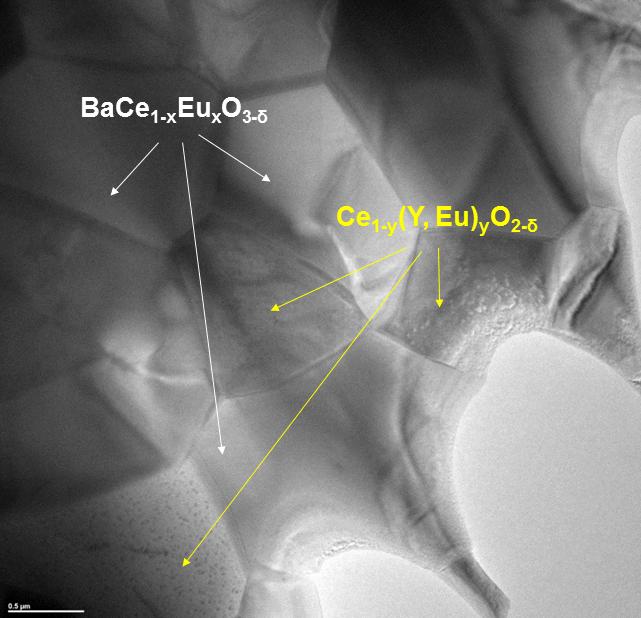Tailor-Made Membranes for the Environment

Transmission electron microscope image of the membrane, provided by the Ernst Ruska-Centre. The two phases for proton and electron conduction are marked in colour. Forschungszentrum Jülich
In technical systems, membranes can be used to separate gases – in a manner that is more efficient and cost-effective than with established methods. Membrane systems thus enable the separation of harmful greenhouse gases with comparatively low losses. At the same time, they also make it possible to obtain high-purity hydrogen for clean energy generation and storage, making ceramic membranes a key technology for transforming the energy sector (Energiewende).
One option for separating hydrogen from gas mixtures is a two-phase membrane. “This consists of two ceramic materials. The individual grains are only a thousandth of a millimetre in size and exhibit both ionic and electronic conductivity,” explains Dr. Mariya Ivanova from the Jülich Institute of Energy and Climate Research.
The components of the hydrogen – protons and electrons – are thus transported individually through the membrane. On the other side, they combine to form high-purity hydrogen. This is made possible by tailor-made vacancies in the crystal lattice of the ceramics, which are occupied by protons. These protons, driven by pressure differences and temperature, are conducted through the material of the membrane.
“They dock onto a hydrogen ion and jump in the direction of the lower pressure to the next hydrogen ion, from vacancy to vacancy, until they form elementary hydrogen again on the other side,” says Mariya Ivanova. “The electrons are transported through the second component of the ceramic and ensure that charge equalization occurs.”
However, the method still has a number of weak points. For example, high temperatures are needed for hydrogen separation, thus meaning it requires a lot of energy. In addition, the membranes investigated so far are not stable and become unusable in a carbonaceous environment. The hydrogen flow rate is also not yet high enough. Nevertheless, the researchers headed by Mariya Ivanova have made some significant progress: by inserting foreign atoms into the crystal lattice, their membrane is more stable and can be used at lower temperatures. However, the greatest achievement is the increased hydrogen flow. “It is nearly twice as high as in all other cases that have been documented to date,” says a delighted Ivanova.
The Jülich membranes used for the measurements are only the size of a 10 cent coin and half a millimetre thick. “It is still too early to be thinking about an industrial application,” explains Ivanova. “We will continue to conduct research, searching for a suitable material with a high flow rate and stability as well as low costs. The next step will be to increase component size to make it fit for industrial application.” The researchers are initially aiming to achieve an area of ten by ten square centimetres.
Original publication:
“Hydrogen separation through tailored dual phase membranes with nominal composition BaCe0.8Eu0.2O3-δ:Ce0.8Y0.2O2-δ at intermediate temperatures” by Mariya E. Ivanova, Sonia Escolástico, Maria Balaguer, Justinas Palisaitis, Yoo Jung Sohn, Wilhelm A. Meulenberg, Olivier Guillon, Joachim Mayer, and Jose M. Serra, DOI: 10.1038/srep34773
Contacts:
Dr. Eng. Mariya E. Ivanova
Head of the hydrogen-permeable membranes team
Tel: +49 2461 61-5194
Email: m.ivanova@fz-juelich.de
Prof. Dr. Olivier Guillon
Director at the Institute of Energy and Climate Research (IEK) Materials Synthesis and Processing
Tel: +49 2461 61-5181
Email: o.guillon@fz-juelich.de
Press contact:
Dr. Regine Panknin
Corporate Communications
Tel: +49 2461 61-9054
Email: r.panknin@fz-juelich.de
http://www.fz-juelich.de/iek/iek-1/EN/Home/home_node.html Institute of Energy and Climate Research: Materials Synthesis and Processing (IEK-1)
http://www.fz-juelich.de/iek/iek-1/EN/Research/Gastrennmembrane/_node.html Gas Separation Membranes at IEK-1
Media Contact
All latest news from the category: Power and Electrical Engineering
This topic covers issues related to energy generation, conversion, transportation and consumption and how the industry is addressing the challenge of energy efficiency in general.
innovations-report provides in-depth and informative reports and articles on subjects ranging from wind energy, fuel cell technology, solar energy, geothermal energy, petroleum, gas, nuclear engineering, alternative energy and energy efficiency to fusion, hydrogen and superconductor technologies.
Newest articles

First-of-its-kind study uses remote sensing to monitor plastic debris in rivers and lakes
Remote sensing creates a cost-effective solution to monitoring plastic pollution. A first-of-its-kind study from researchers at the University of Minnesota Twin Cities shows how remote sensing can help monitor and…

Laser-based artificial neuron mimics nerve cell functions at lightning speed
With a processing speed a billion times faster than nature, chip-based laser neuron could help advance AI tasks such as pattern recognition and sequence prediction. Researchers have developed a laser-based…

Optimising the processing of plastic waste
Just one look in the yellow bin reveals a colourful jumble of different types of plastic. However, the purer and more uniform plastic waste is, the easier it is to…



